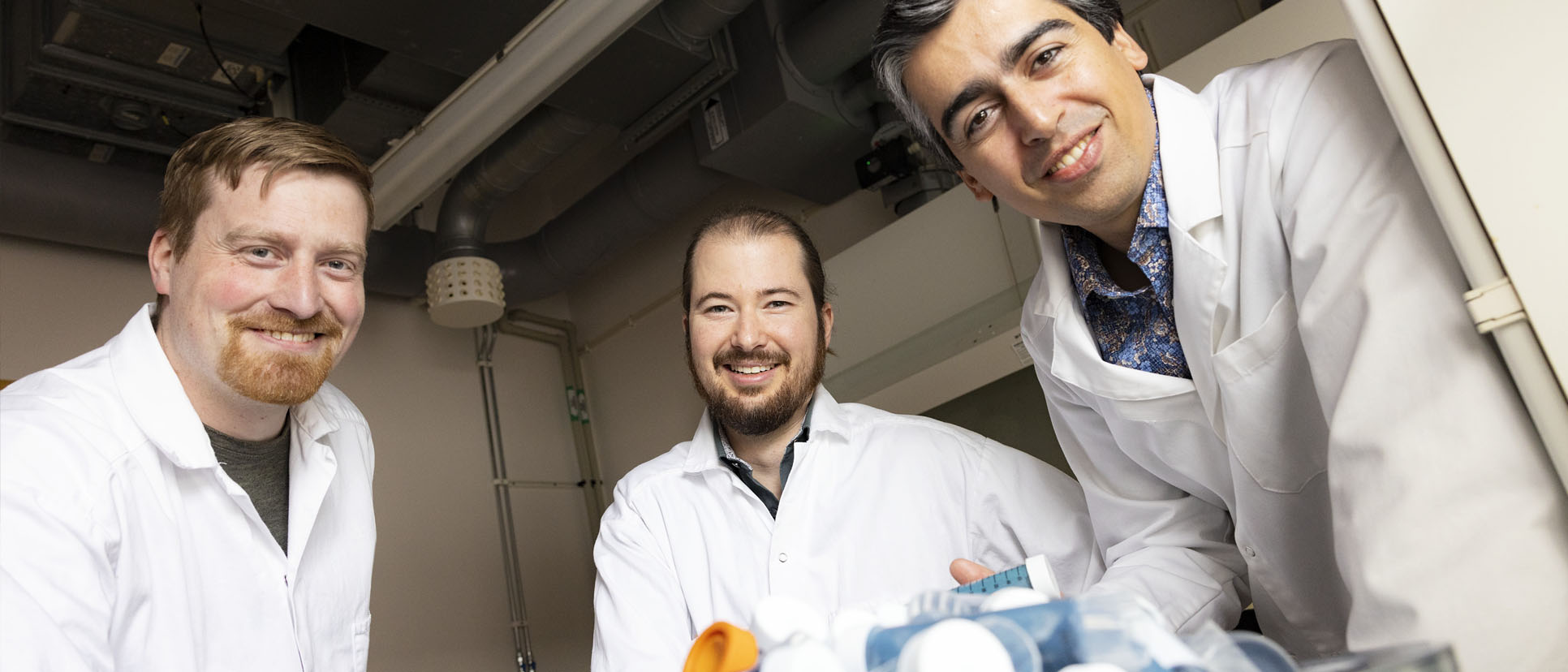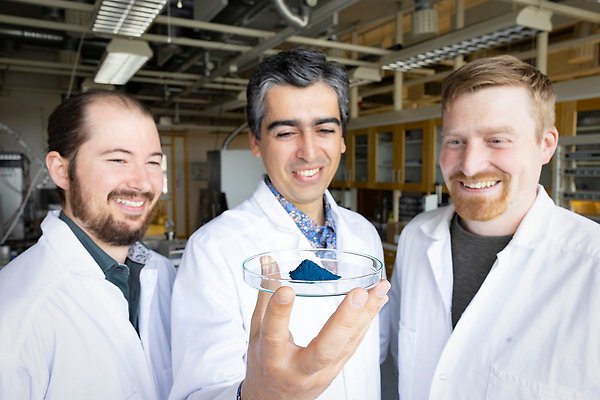Major successes for Uppsala University researchers’ battery material

Researchers Ronnie Mogensen, William Brant and Reza Younesi around research samples of the cathode material Fennac, or Prussian white, which will now be produced on an industrial scale in Sandviken. Photo: Mikael Wallerstedt
Uppsala-based battery company Altris AB was recently given the green light for funding to the tune of SEK 100 million. The company’s roots are at the Ångström Laboratory, where development of the innovative manufacturing method continues. “Our cathode materials allow us to make more sustainable, cheaper and safer sodium-ion batteries,” says Reza Younesi, researcher at the Department of Chemistry Ångström Laboratory.
When they meet at the Division of Structural Chemistry, the three chemistry researchers who founded Altris are looking especially pleased. Only the day before, it was confirmed that their cathode material Fennac will go into production on an industrial scale in Sandviken. The factory will manufacture approximately 2,000 tonnes of cathode material annually for use in rechargeable sodium-ion batteries. This corresponds to an energy storage capacity of 1 gigawatt, or the annual electricity consumption of approximately 40 average houses.
This was the second piece of good news received by Altris in a short period of time. In March, the company’s Series A investment round netted in the region of €9.6 million from companies such as Northvolt and EIT InnoEnergy. The fact that this triumvirate of researchers has reached this point is of course down to hard work; that said, a number of factors have been in their favour along the way since doctoral student Ronnie Mogensen joined the division in 2015 to conduct research into sodium-ion batteries.
Synthesis at low temperatures
“We were probably fortunate to come up with this method for synthesising “Prussian White” (as Fennec is often known), which is based on sodium ions. Our breakthrough was that we succeeded in synthesising the material at low temperatures and without high pressure, making the manufacturing process cheaper,” says Mogensen.

The success of Altris' sodium ion battery is based on a unique method of synthesizing the material “Prussian White”, which despite the name has an original blue colour. Photo: Mikael Wallerstedt
Sodium-ion was the natural choice over lithium, a mineral that is both expensive and limited to certain regions of the world. Instead, the researchers use raw materials and chemicals that are available on practically all continents.
“Our cathode material consists of iron, nitrogen, sodium and carbon, basically elements we have in abundance,” explains Younesi. Another component is aluminium, which is used in place of copper, making the battery cheaper and easier to manufacture.
While sodium-ion batteries do have lower energy density per unit, according to Younesi their storage capacity is perfectly adequate for standard applications. Still, the company is not seeking to outcompete lithium batteries, but rather to complement them. In addition to easing pressure on global natural and water resources, sodium-ion batteries are also significantly safer, as William Brandt explains.
Meeting safety needs
“Unlike lithium-ion batteries, sodium-ion batteries do not contain nickel, a component that in combination with highly flammable electrolytes makes lithium-ion batteries a fire hazard. Altris uses nickel-free chemistry and non-flammable electrolytes. So, the end product for the user is a battery that can match certain lithium-ion technologies while meeting safety needs.”
The researchers still use the Ångström Advanced Battery Centre, among other things to test battery cells, as well as other facilities both within and outside the Ångström Laboratory.
“The battery market is extremely dynamic at the moment and we have the chance to demonstrate juts how promising our battery technology is,” says Mogensen.
Anneli Björkman
